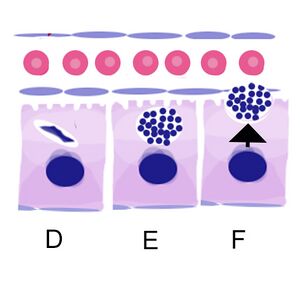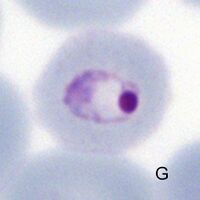Pre-erythrocytic (liver) stage: Difference between revisions
From haematologyetc.co.uk
No edit summary |
No edit summary |
||
| Line 9: | Line 9: | ||
{| class="wikitable" style="border-style: solid; border-width: 5px; border-color: #023020; color:black" | {| class="wikitable" style="border-style: solid; border-width: 5px; border-color: #023020; color:black" | ||
|colspan="1" style = "font-size:100%; color:black; background: #afbddb |'''The | |colspan="1" style = "font-size:100%; color:black; background: #afbddb |'''The initial infection of the host''' | ||
|} | |} | ||
| Line 22: | Line 22: | ||
{| class="wikitable" style="border-style: solid; border-width: 5px; border-color: #023020; color:black" | {| class="wikitable" style="border-style: solid; border-width: 5px; border-color: #023020; color:black" | ||
|colspan="1" style = "font-size:100%; color:black; background: #afbddb |''' | |colspan="1" style = "font-size:100%; color:black; background: #afbddb |'''Infection and replication in liver''' | ||
|} | |} | ||
| Line 35: | Line 35: | ||
{| class="wikitable" style="border-style: solid; border-width: 5px; border-color: #023020; color:black" | {| class="wikitable" style="border-style: solid; border-width: 5px; border-color: #023020; color:black" | ||
|colspan="1" style = "font-size:100%; color:black; background: #afbddb |''' | |colspan="1" style = "font-size:100%; color:black; background: #afbddb |'''From liver to blood''' | ||
|} | |} | ||
The parasites in liver cells (D) then undergo repeated cycles of asexual replication (E) to form schizonts which are similar to the schizont stage in blood. At the end of the process the '''“merozoites”''' that are formed are released into blood (F). | |||
<gallery mode="nolines" widths="300px" heights="300px" > | <gallery mode="nolines" widths="300px" heights="300px" > | ||
File:Liver 2.jpg|Mature schizont releasing merozoites|link={{filepath:Liver 2.jpg}} | File:Liver 2.jpg|Mature schizont releasing merozoites|link={{filepath:Liver 2.jpg}} | ||
</gallery> | </gallery> | ||
They then infect red cells and now have the typical appearance of early trophozoite (G). | |||
<gallery mode="nolines" widths="200px" heights="200px" > | <gallery mode="nolines" widths="200px" heights="200px" > | ||
| Line 52: | Line 54: | ||
{| class="wikitable" style="border-style: solid; border-width: 5px; border-color: #023020; color:black" | {| class="wikitable" style="border-style: solid; border-width: 5px; border-color: #023020; color:black" | ||
|colspan="1" style = "font-size:100%; color:black; background: #afbddb |'''Relevance of | |colspan="1" style = "font-size:100%; color:black; background: #afbddb |'''Relevance of hepatic stage to clinical biology''' | ||
|} | |} | ||
---- | ---- | ||
Revision as of 10:49, 22 April 2024
Navigation
(click blue highlighted text to return to page)
Malaria main index
>Basic malaria biology
>>This page: Pre-erythrocytic (liver) stage
| The initial infection of the host |
The initial mosquito bite (Image A): blood from the host is taken through as mosquito mouthparts (m) from small vessels (v). At the same time fluid from mosquito salivary glands passes into the vessel. If a mosquitos is host to the malaria organism then parasites enter the blood with this saliva (in the form of "sporozoites" (sp)).
| Infection and replication in liver |
The sporozoites that have entered the blood then pass through the blood vessel and into the cells of the liver (B). They may pass through multiple cells but then remain in a single liver cell (C).
| From liver to blood |
The parasites in liver cells (D) then undergo repeated cycles of asexual replication (E) to form schizonts which are similar to the schizont stage in blood. At the end of the process the “merozoites” that are formed are released into blood (F).
They then infect red cells and now have the typical appearance of early trophozoite (G).
| Relevance of hepatic stage to clinical biology |



